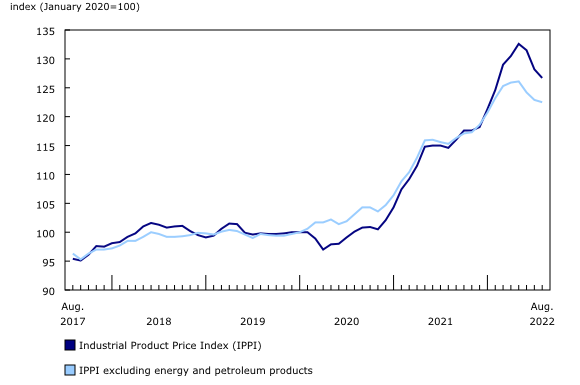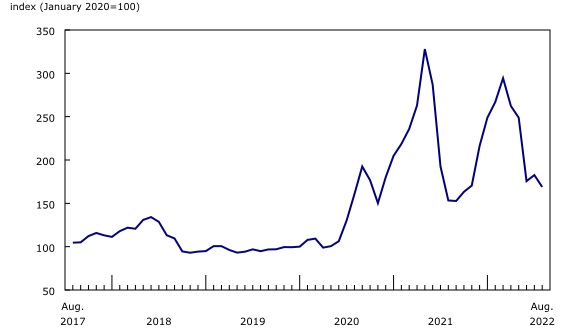Industrial product and raw materials price indexes, August 2022
Released: 2022-09-19
The Industrial Product Price Index (IPPI) declined 1.2% month over month in August. Year over year, the IPPI increased 10.6%. Prices of raw materials purchased by manufacturers operating in Canada, as measured by the Raw Materials Price Index (RMPI), fell 4.2% on a monthly basis in August and increased 17.6% year over year.
Industrial Product Price Index
Prices for products sold by manufacturers operating in Canada, as measured by the IPPI, declined 1.2% month over month in August, a third consecutive monthly decrease. The IPPI increased 10.6% year over year.
Prices for energy and petroleum products fell 6.5% in August, leading the monthly decrease in the IPPI. Prices for refined petroleum energy products (-7.0%) fell for a second consecutive month, mainly due to lower prices for finished motor gasoline (-9.6%) and diesel fuel (-3.6%). Despite the monthly decrease, prices for refined petroleum energy products were 51.1% higher compared with August 2021 and 65.1% higher compared with January 2020. Falling prices for refined petroleum products are linked to lower prices for crude oil, which fell 9.6% in August. Increased global production of crude, higher inventories and macroeconomic concerns all played a part in the decreased prices. Furthermore, the United States has been releasing barrels of oil from its Strategic Petroleum Reserve to ease the pressure on crude prices. According to data from the US Department of Energy, 22.9 million barrels were released in August 2022.
Excluding energy and petroleum products, the IPPI was down 0.3% in August. Prices for ammonia and chemical fertilizers fell by 19.3%, a record monthly drop. Volatility in the fertilizer market is linked to natural gas prices, as natural gas is the main feedstock for nitrogen-based fertilizers, such as urea and ammonia. Fertilizer prices were up 42.8% year over year and up 95.8% compared with January 2020. High natural gas prices have led to curtailed fertilizer production in Europe, as plants were forced to close or reduce output.
The price of softwood lumber fell 7.5% in August, continuing the downward trend that started in April. In August, prices were up 10.2% compared with the same month in 2021 and were 68.9% higher than in January 2020. Higher interest rates and a slowing US housing market both played a role in the monthly decrease. In July, US housing starts dropped 9.6%, the lowest level since February 2021. As of the first week of September 2022, the average rate for a 30-year fixed mortgage in the United States was 5.9%, a level last observed in 2008.
Prices for primary ferrous metal products were down 2.1% in August, mainly due to a drop in prices for basic and semi-finished iron or steel products (-2.2%). Year over year, primary ferrous metal products fell 6.0%, the first yearly decrease since September 2020 (-2.2%). Lower prices for steel are partially due to slowing demand in China amidst a softening property market.
Raw Materials Price Index
In August, the RMPI fell 4.2% month over month, mainly driven by lower prices for crude energy products (-9.6%). However, the RMPI was up 17.6% compared with August 2021.
Prices for conventional crude oil dropped 8.1% in August. Year over year, conventional crude oil prices rose 42.5%. Crude prices were driven globally, both by pessimistic macroeconomic sentiment and increased global production. According to data from the U.S. Energy Information Administration, in August, global production of petroleum was 101.3 million barrels per day (Mbpd) and consumption was 99.4 Mbpd.
Natural gas prices in Canada fell 19.4% in August, with increased production, pipeline capacity, and unplanned outages all playing a role in the significant price drop. This price movement is unique to Canada, as natural gas prices were high globally. In August, the monthly average price of natural gas in Europe was US$70.04 per btu, compared with $2.86 in August 2020. In the United States, the August 2022 price was US$8.79 per btu, compared with $2.30 in August 2020.
In August, prices for crop products (-3.5%) fell for a third consecutive month and increased 2.0% compared with the same month in 2021. Prices for grains (except wheat) fell 7.2% in August, while the price of wheat decreased 6.6%. The latest model based field crop estimates predict higher production of wheat, canola, barley, oats, soybeans and corn for grain in 2022. Additionally, the resumption of exports from the Black Sea ports in Ukraine placed downward pressure on global wheat prices.
Prices for gold, silver, and platinum group metal ores and concentrates (+4.7%) were mainly responsible for the monthly increase in metal ores, concentrates and scrap (+2.0%). The short-term price movement for gold and silver in August may have been influenced by market participants covering short positions, as well as expectations of softening US inflation.
Note to readers
The Industrial Product Price Index (IPPI) and the Raw Materials Price Index (RMPI) are available at the Canada level only. Selected commodity groups within the IPPI are also available by region.
With each release, data for the previous six months may have been revised. The indexes are not seasonally adjusted.
The IPPI reflects the prices that producers in Canada receive as goods leave the plant gate. The IPPI does not reflect what the consumer pays. Unlike the Consumer Price Index, the IPPI excludes indirect taxes and all costs that occur between the time a good leaves the plant and the time the final user takes possession of the good. This includes transportation, wholesale and retail costs.
Canadian producers export many goods. They often indicate their prices in foreign currencies, especially in US dollars, which are then converted into Canadian dollars. This is particularly the case for motor vehicles, pulp and paper products, and wood products. Therefore, fluctuations in the value of the Canadian dollar against its US counterpart affect the IPPI. However, the conversion to Canadian dollars reflects only how respondents provide their prices. This is not a measure that takes into account the full effect of exchange rates.
The conversion of prices received in US dollars is based on the average monthly exchange rate established by the Bank of Canada and available in Table 33-10-0163-01 (series v111666275). Monthly and annual variations in the exchange rate, as described in the release, are calculated according to the indirect quotation of the exchange rate (for example, CAN$1 = US$X).
The RMPI reflects the prices paid by Canadian manufacturers for key raw materials. Many of those prices are set on the world market. However, as few prices are denominated in foreign currencies, their conversion into Canadian dollars has only a minor effect on the calculation of the RMPI.
Products
The product "Industrial Product Price Index: 2021 Annual Review" is now available. This document is a review of how producer prices, as measured by the IPPI, changed in 2021 compared with 2020. In 2021, a multitude of factors influenced prices, many of which stemmed from the COVID-19 pandemic. Economies reopened slowly, as lockdowns were lifted and vaccinations became available, driving up demand.
Statistics Canada launched the Producer Price Indexes Portal as part of a suite of portals for prices and price indexes. This webpage provides Canadians with a single point of access to a variety of statistics and measures related to producer prices.
The video "Producer price indexes" is available on the Statistics Canada Training Institute webpage. It introduces Statistics Canada's producer price indexes—what they are, how they are made, and what they are used for.
Addition of a new table and additional data
Effective February 28, 2022, table 18-10-0272-01 has been added to the Statistics Canada website featuring regional indexes for select refined petroleum products. In addition, tables 18-10-0266-01 and 18-10-0268-01 now contain data for select 6- and 7-digit North American Product Classification System series.
Next release
The industrial product and raw materials price indexes for September will be released on October 19.
Contact information
For more information, or to enquire about the concepts, methods or data quality of this release, contact us (toll-free 1-800-263-1136; 514-283-8300; infostats@statcan.gc.ca) or Media Relations (statcan.mediahotline-ligneinfomedias.statcan@statcan.gc.ca).
- Date modified:





